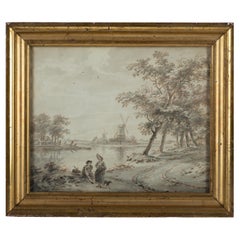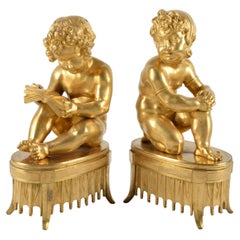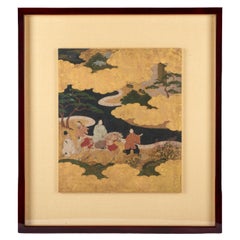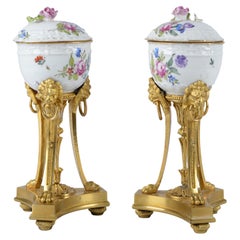
Established in 20041stDibs seller since 2007
Featured Pieces
18th Century River Landscape Drawing, Dutch School
Located in Kittery Point, ME
Drawing, wash and ink on paper.
River Landscape with a couple and a dog in the foreground and windmills and farmers in the background, in the manner of Nicolaes Wicart. Set in a 19th...
Category
Antique Late 18th Century Dutch Neoclassical Drawings
Materials
Paper
Pair of Directoire Gilt Bronze Allegorical Sculptures of Children
Located in Kittery Point, ME
Each child seated on an oval tasseled and draped plinth in the shape of a stool, one reading a book, the other thinking, symbolizing knowledge and philosophy.
Category
Antique Late 18th Century French Directoire Figurative Sculptures
Materials
Ormolu
Painting of a Tale of Genji Scene, Tosa School
By Tosa School
Located in Kittery Point, ME
Japanese 17th century school "Tale of Genji Scene" painting on paper, mounted to board. Nicely framed and boxed.
Professor Melissa McCormick at Harvard b...
Category
Antique 17th Century Japanese Japonisme Decorative Art
Materials
Paint, Paper
Pair of Louis XVI Ormolu Mounted Chantilly Porcelain Pots de Crème
Located in Kittery Point, ME
Each porcelain pot delicately decorated with flowers and raised on an exquisitely chased tripod base headed by lion heads.
These Chantilly porcelain pots were embellished in Paris wi...
Category
Antique Late 18th Century French Louis XVI Urns
Materials
Ormolu
A Louis XVI Ormolu Figural Cartel Clock
Located in Kittery Point, ME
A Louis XVI Ormolu Figural Cartel Clock, the circular white enamel dial signed "Baudoin A Paris" within a cartouche-shaped case surmounted by an urn and ...
Category
Antique Late 18th Century French Neoclassical Wall Clocks
Materials
Ormolu
Louis XVI Giltwood Mirror 'A la Grecque'
Located in Kittery Point, ME
The Louis XVI Giltwood Mirror in the ‘goût grec’ taste, of rectangular shape surmounted by an urn in a circle and hung with a ribbon-tied pendant foliate swag partially wrapping each...
Category
Antique 1770s Neoclassical Mantel Mirrors and Fireplace Mirrors
Materials
Giltwood
Large Late Louis XV Giltwood Mirror
Located in Kittery Point, ME
Rare Late Louis XV Giltwood Mirror 'A La Grecque'
The divided rectangular plate surmounted by a trophy cresting shaped as an urn flanked by flowering vases on each side and hung with...
Category
Antique 1760s Neoclassical Wall Mirrors
Materials
Giltwood
Pair of Large Italian Rococo Giltwood Mirrors (Girandoles)
Located in Kittery Point, ME
Pair of Roman Rococo Giltwood Mirrors (Girandoles), each shaped plate within a cartouche-shaped frame surmounted by a pierced fan-shaped cresting carved with bunches of grapes, flowe...
Category
Antique Mid-18th Century Italian Rococo Wall Mirrors
Materials
Giltwood
Directoire Mahogany Bergère Attributed to Georges Jacob
By Georges Jacob
Located in Kittery Point, ME
A Directoire Mahogany Bergère Attributed to Georges Jacob, its curved back and padded armrests with finely carved baluster-shaped supports raised on turned front legs and sabre back legs.
With a spurious Jacob stamp to back rail.
The term "Directoire" refers to a historical period following the French Revolution (1789) and preceding the First Empire when Napoleon reigned, but also to a style of furniture and decoration covering a longer period from 1789 to 1804. It is characterized by the production of furniture with simplified forms and ornaments, inspired by antique decorations.
The profound social and political upheavals that marked this period had a direct impact on the production of Directoire furniture. The stripping down of furniture pieces, which had begun in the 1780s under the influence of Greek art, was accentuated during this period. The abolition of guilds by the revolutionaries also forced manufacturers in the Faubourg Saint-Antoine to simplify shapes and materials.
Elegant and graceful, the furniture is generally small-scale. They retain the Louis XVI structure. The Directoire style adopts clean shapes, straight lines, simple curves, flat surfaces and right angles. Lines accentuate geometric shapes inspired by Antiquity. A typical trait is the pronounced rolled-over back, similar to a scroll illustrated in our bergere, evocative of the klismos chair. Only the more luxurious pieces of furniture use mahogany, an exotic and expensive wood.
Despite his humble origins, Georges Jacob rose to become one of the most renowned menuisiers of his day. Unlike many artisans who joined their fathers or brothers in the middle-class family trade of furniture making, Jacob was from a peasant family and moved to Paris at sixteen to begin his career. He apprenticed in a joinery workshop and eventually became a master in 1765. He developed a reputation for producing inventive designs for chairs, beds, and screens carved with such motifs as twisted ribbons, guilloches, beading, and fluting.
Jacob's reputation grew quickly, eventually spreading outside France; the future King George IV of England, Gustavus III of Sweden, and several German princes...
Category
Antique Late 18th Century French Directoire Bergere Chairs
Materials
Mahogany
Large Dutch Delft Faience Blue and White Chinoiserie Baluster Lamp
Located in Kittery Point, ME
Late 17th Century Large Dutch Delft Faience Blue and White Chinoiserie Baluster Vase Mounted as a Lamp and newly electrified.
Of octagonal shape, decorated with oriental figures in a landscape.
The dimensions indicated herein include the lampshade. The vase only with its base and cover is approximately 12in. high by 8in. diameter.
The arrival in Western Europe of the first shiploads of Chinese porcelain, lacquerware, ivory and silk in the 17th century stimulated interest in China, or Cathay, as it was then called. Europeans soon began copying the Chinese artworks and decorative objects. These decorative arts inspired by China, which enjoyed their heyday in the late 17th, 18th and early 19th centuries, are known as chinoiserie.
Soon after the introduction of expensive Chinese...
Category
Antique Late 17th Century Dutch Chinoiserie Table Lamps
Materials
Faience
Dutch Delft Faience Blue and White Chinoiserie Baluster Vase Mounted as a Lamp
Located in Kittery Point, ME
Late 17th Century Dutch Delft Faience Blue and White Chinoiserie Baluster Vase Mounted as a Lamp and newly electrified.
Decorated in imitation of a Chinese Ming vase with a sage, rocks and vegetation, mounted on a wood base.
The dimensions noted include the lampshade and electrical fittings. The vase as mounted in wood is approximately 10in. high and 6in. diameter.
The arrival in Western Europe of the first shiploads of Chinese porcelain, lacquerware, ivory and silk in the 17th century stimulated interest in China, or Cathay, as it was then called. Europeans soon began copying the Chinese artworks and decorative objects. These decorative arts inspired by China, which enjoyed their heyday in the late 17th, 18th and early 19th centuries, are known as chinoiserie.
Soon after the introduction of expensive Chinese...
Category
Antique Late 17th Century Dutch Chinoiserie Table Lamps
Materials
Faience
Pair of Louis XIII Ebony Carved Tondos
Located in Kittery Point, ME
Each ebony tondo carved with Roman military scenes in low relief, set in gilt Florentine style frames. Formerly part of the front doors of a cabinet. With an old label at the back of the frame, Ernest Samson, Paris.
13 1/4in. diameter sight (the dimensions otherwise indicated include the frame).
These beautifully carved panels would have been part of the doors of a cabinet made to impress in a grand room in an aristocratic or royal setting. They reflect the changing taste in the first half of the 17th century for large sumptuous pieces for grand galleries and grand state apartments in royal and courtly interiors. It was not until the 17th century that France began to import exotic timbers from the Far East and South America and ebony was one of the first of these woods to be employed in cabinet-making. However, due to its rarity and cost it was almost exclusively used for veneering. French cabinetmakers who worked with ebony became known as menuisiers en ébène and later ébénistes. The carved and engraved ornament and ripple mouldings reflect the light on the glossy ebony surface.
The subject-matter of these bas-relief carvings was inspired by prints with religious, mythological or literary subjects and naturalistic engraved motifs. According to Alcouffe 'These cabinets represent the synthesis of foreign (especially German) influences and traditions expressed in French Renaissance furniture...
Category
Antique Early 17th Century French Louis XIII Wall-mounted Sculptures
Materials
Ebony



